Large-scale land ownership needs to be embraced if government is to reach environment and housing targets, report claims
Fragmented land use and ownership will put Scotland at risk of failing to reach its targets on rural housing and nature and the environment, a new report has said.
Peatland restoration, for example, needs to increase by more than 300 per cent to reach Scottish Government targets of 250,000 hectares of restored peatland by 2030.
Advertisement
Hide AdAdvertisement
Hide AdCurrently, these projects on a large scale – on land more than 200 hectares – account for 57 per cent of the 42,3000 hectares of peatland that has been restored since 2013, the report said. This is in comparison to 25 per cent of the target having been achieved through small-scale projects of less than 100 hectares.


The report, “Land: the Role of Scale in Delivering a Just Transition”, was commissioned by landowner membership organisation Scottish Land & Estates (SLE) and published by independent consultancy firm BiGGAR Economics.
It comes as the Scottish Government prepares to publish a new Land Reform Bill which some critics have said does not go far enough in tackling inequalities in land ownership.
The report dives into other areas such as forestry and housing, giving examples of how large-scale land management and ownership is helping Scotland reach its targets.
On forestry, for example, authors found that since 2015, 45,000 hectares of woodland has been planted with support from the Forestry Grant Scheme. The Scottish Government aims to create enough woodland to cover 21 per cent of Scotland’s total area by 2032 but, at the current rate of delivery, it would take almost 48 years to reach this target through only small-scale projects of 0-50 hectares.
The need to increase housebuilding is also examined, with the annual requirement for 26,000 new homes a year not being met in any year since 2007/8.
The report said at least five rural estates are known to be leading large-scale housing developments of up to 5,000 homes. These estates include some of
the largest in Scotland, those of 40,000 hectares or more.
The findings were presented to MSPs at a parliamentary event hosted by Kate Forbes, MSP for Skye, Lochaber and Badenoch, this week.
Advertisement
Hide AdAdvertisement
Hide AdThe SNP MSP said: “There is no doubt that land-based businesses can make significant contributions to achieving Scotland’s public policy objectives, including woodland creation, peatland restoration and renewable energy.
“The delivery of these projects at scale is going to be absolutely critical if we are to achieve these targets at the required pace and quality of delivery.”
Sarah-Jane Laing, chief executive of SLE, said: “Ambitious targets have been set by the Scottish Government across net zero, nature and housing and if there is any hope of these being met, working at scale is the best way to achieve that.
“It is clear from the research that fragmentation of land use ownership will both reduce the pace of delivery and also the level of investment available. Delivery of homes by large landowners, and large-scale projects for nature involving single or fewer landowners, tend to be less complex, contain fewer risks and are quicker to deliver than projects with governance agreements between multiple parties.
“Landowners of all types and sizes are making a significant contribution to Scotland’s wellbeing but if the government wants to meet its targets then it should be looking to retain or even increase scale. Forthcoming land reform proposals are likely to put delivery and investment at risk.”
Comments
Want to join the conversation? Please or to comment on this article.